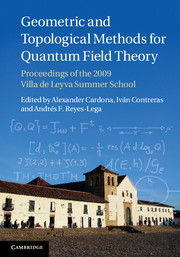 Geometric and Topological Methods for Quantum Field Theory
Geometric and Topological Methods for Quantum Field Theory Published online by Cambridge University Press: 05 May 2013
Abstract
In these lecture notes I will give an introduction to Feynman integrals. In the first part I review the basics of the perturbative expansion in quantum field theories. In the second part I will discuss more advanced topics: mathematical aspects of loop integrals related to periods, shuffle algebras and multiple polylogarithms are covered as well as practical algorithms for evaluating Feynman integrals.
Introduction
In these lecture notes Iwill give an introduction to perturbation theory and Feynman integrals occurring in quantum field theory. But before embarking onto a journey of integration and special function theory, it is worth recalling the motivation for such an effort.
High-energy physics is successfully described by the Standard Model. The term “Standard Model” has become a synonym for a quantum field theory based on the gauge group SU(3) ⊗ SU(2) ⊗ U(1). At high energies all coupling constants are small and perturbation theory is a valuable tool to obtain predictions from the theory. For the Standard Model there are three coupling constants, g1, g2 and g3, corresponding to the gauge groups U(1), SU(2) and SU(3), respectively. As all methods which will be discussed below do not depend on the specific nature of these gauge groups and are even applicable to extensions of the Standard Model (like super-symmetry), I will just talk about a single expansion in a single coupling constant. All observable quantities are taken as a power series expansion in the coupling constant, and calculated order by order in perturbation theory.
To save this book to your Kindle, first ensure [email protected] is added to your Approved Personal Document E-mail List under your Personal Document Settings on the Manage Your Content and Devices page of your Amazon account. Then enter the ‘name’ part of your Kindle email address below. Find out more about saving to your Kindle.
Note you can select to save to either the @free.kindle.com or @kindle.com variations. ‘@free.kindle.com’ emails are free but can only be saved to your device when it is connected to wi-fi. ‘@kindle.com’ emails can be delivered even when you are not connected to wi-fi, but note that service fees apply.
Find out more about the Kindle Personal Document Service.
To save content items to your account, please confirm that you agree to abide by our usage policies. If this is the first time you use this feature, you will be asked to authorise Cambridge Core to connect with your account. Find out more about saving content to Dropbox.
To save content items to your account, please confirm that you agree to abide by our usage policies. If this is the first time you use this feature, you will be asked to authorise Cambridge Core to connect with your account. Find out more about saving content to Google Drive.